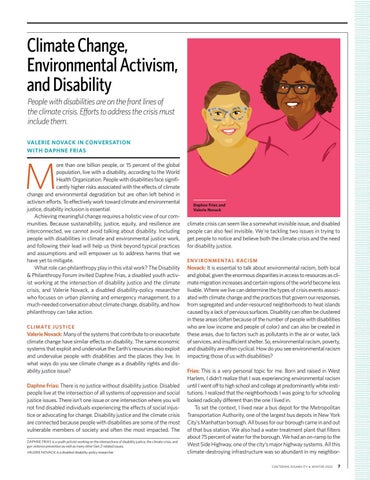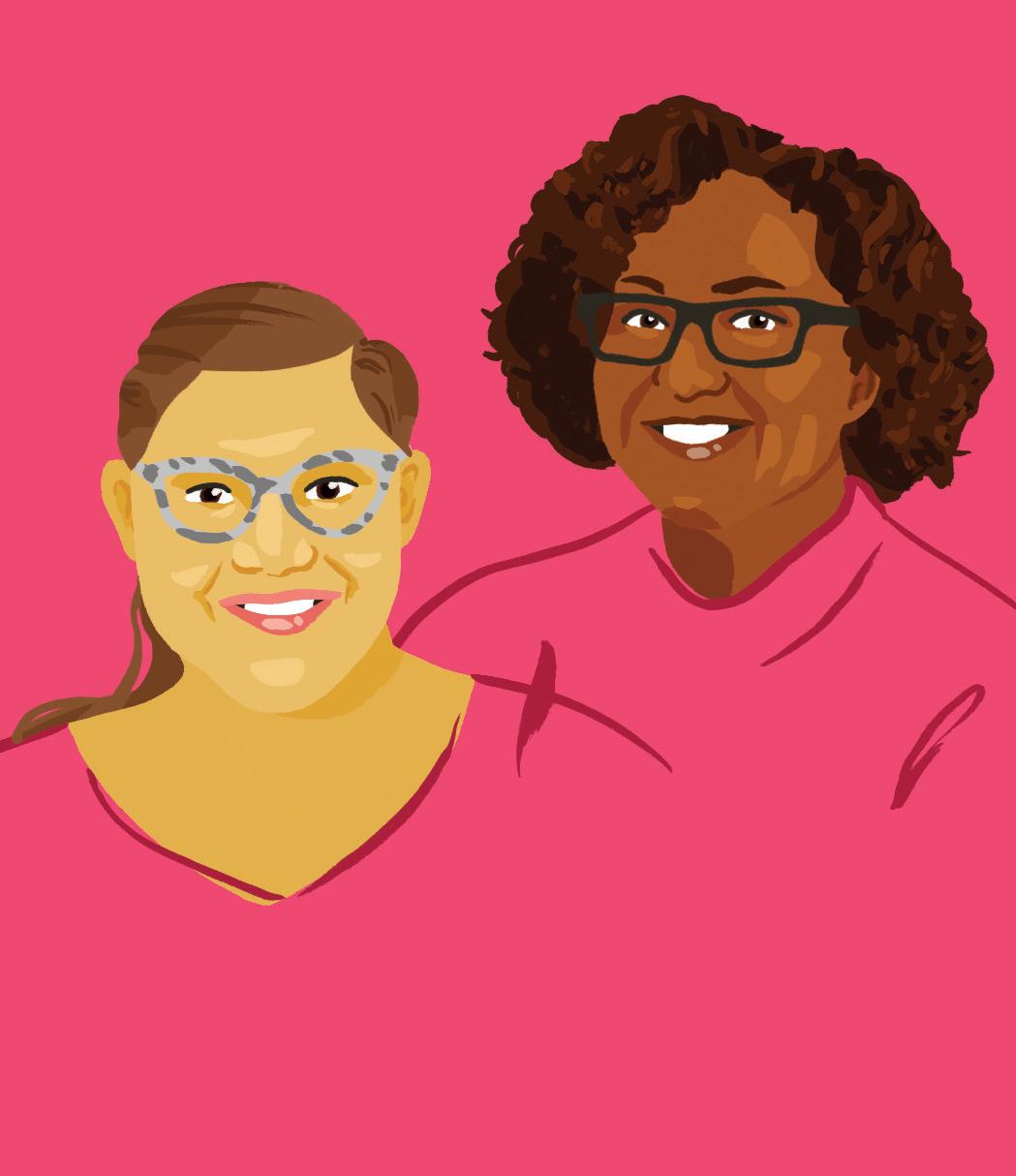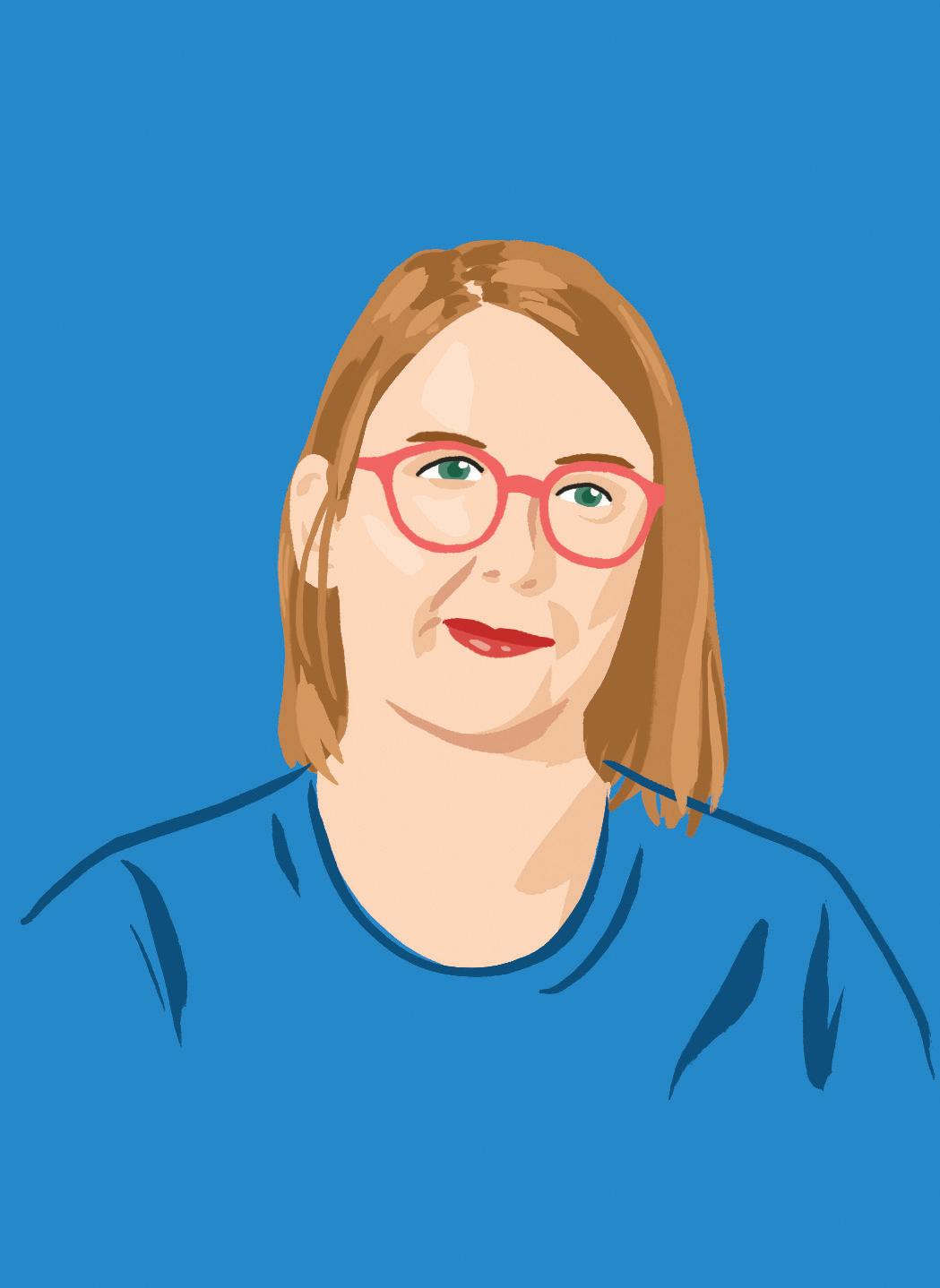Climate Change, Environmental Activism, and Disability People with disabilities are on the front lines of the climate crisis. Efforts to address the crisis must include them. VALERIE NOVACK IN CONVERSATION WITH DAPHNE FRIAS
M
ore than one billion people, or 15 percent of the global population, live with a disability, according to the World Health Organization. People with disabilities face significantly higher risks associated with the effects of climate change and environmental degradation but are often left behind in activism efforts. To effectively work toward climate and environmental justice, disability inclusion is essential. Achieving meaningful change requires a holistic view of our communities. Because sustainability, justice, equity, and resilience are interconnected, we cannot avoid talking about disability. Including people with disabilities in climate and environmental justice work, and following their lead will help us think beyond typical practices and assumptions and will empower us to address harms that we have yet to mitigate. What role can philanthropy play in this vital work? The Disability & Philanthropy Forum invited Daphne Frias, a disabled youth activist working at the intersection of disability justice and the climate crisis, and Valerie Novack, a disabled disability-policy researcher who focuses on urban planning and emergency management, to a much-needed conversation about climate change, disability, and how philanthropy can take action.
C L I M AT E J U S T I C E
Valerie Novack: Many of the systems that contribute to or exacerbate climate change have similar effects on disability. The same economic systems that exploit and undervalue the Earth’s resources also exploit and undervalue people with disabilities and the places they live. In what ways do you see climate change as a disability rights and disability justice issue? Daphne Frias: There is no justice without disability justice. Disabled people live at the intersection of all systems of oppression and social justice issues. There isn’t one issue or one intersection where you will not find disabled individuals experiencing the effects of social injustice or advocating for change. Disability justice and the climate crisis are connected because people with disabilities are some of the most vulnerable members of society and often the most impacted. The DAPHNE FRIAS is a youth activist working on the intersections of disability justice, the climate crisis, and gun violence prevention as well as many other Gen Z-related issues. VALERIE NOVACK is a disabled disability-policy researcher.
Daphne Frias and Valerie Novack
climate crisis can seem like a somewhat invisible issue, and disabled people can also feel invisible. We’re tackling two issues in trying to get people to notice and believe both the climate crisis and the need for disability justice. E N V I R O N M E N TA L R A C I S M
Novack: It is essential to talk about environmental racism, both local and global, given the enormous disparities in access to resources as climate migration increases and certain regions of the world become less livable. Where we live can determine the types of crisis events associated with climate change and the practices that govern our responses, from segregated and under-resourced neighborhoods to heat islands caused by a lack of pervious surfaces. Disability can often be clustered in these areas (often because of the number of people with disabilities who are low income and people of color) and can also be created in these areas, due to factors such as pollutants in the air or water, lack of services, and insufficient shelter. So, environmental racism, poverty, and disability are often cyclical. How do you see environmental racism impacting those of us with disabilities? Frias: This is a very personal topic for me. Born and raised in West Harlem, I didn’t realize that I was experiencing environmental racism until I went off to high school and college at predominantly white institutions. I realized that the neighborhoods I was going to for schooling looked radically different than the one I lived in. To set the context, I lived near a bus depot for the Metropolitan Transportation Authority, one of the largest bus depots in New York City’s Manhattan borough. All buses for our borough came in and out of that bus station. We also had a water treatment plant that filters about 75 percent of water for the borough. We had an on-ramp to the West Side Highway, one of the city’s major highway systems. All this climate-destroying infrastructure was so abundant in my neighborCENTERING DISABILITY
• WINTER 2022
7
.......... .......... .......... .......... .......... .......... .......... .......... .......... .......... .......... .......... .......... .......... .......... .......... .......... .......... .......... .......... .......... .......... .......... .......... .......... .......... .......... .......... .......... .......... .......... .......... .......... .......... .......... .......... .......... .......... .......... .......... .......... .......... .......... .......... .......... .......... .......... .......... .......... .......... .......... .......... .......... .......... .......... .......... .......... .......... .......... .......... .......... .......... .......... .......... .......... .......... .......... .......... .......... .......... .......... .......... .......... .......... .......... .......... .......... .......... .......... .......... .......... .......... .......... .......... .......... .......... .......... .......... .......... .......... .......... .......... .......... .......... .......... .......... .......... .......... .......... .......... .......... .......... .......... .......... .......... .......... .......... .......... .......... .......... .......... .......... .......... .......... .......... .......... .......... .......... .......... .......... .......... .......... .......... .......... .......... .......... .......... .......... .......... .......... .......... .......... .......... .......... .......... .......... .......... .......... .......... .......... .......... .......... .......... .......... .......... .......... .......... .......... .......... .......... .......... .......... .......... .......... .......... .......... .......... .......... .......... .......... .......... .......... .......... .......... .......... .......... .......... .......... .......... .......... .......... .......... .......... .......... .......... .......... .......... .......... .......... .......... .......... .......... .......... .......... .......... .......... .......... .......... .......... .......... .......... .......... .......... .......... .......... .......... .......... .......... .......... .......... .......... .......... .......... .......... .......... .......... .......... .......... .......... .......... .......... .......... .......... .......... .......... .......... .......... .......... .......... .......... .......... .......... .......... .......... .......... .......... .......... .......... .......... .......... .......... .......... .......... .......... .......... .......... .......... .......... .......... .......... .......... .......... .......... .......... .......... .......... .......... .......... .......... .......... .......... .......... .......... .......... .......... .......... .......... .......... .......... .......... ..........






